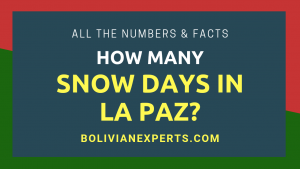In Bolivia, you won’t find extremely hot temperatures like in other countries, but certainly, the country has its warm period each year. This time goes from the end of each year to the beginning of the following year, occurring in part of Spring and Summer. Temperatures will rarely go below 60°F or go above 100°F during this time.
In Bolivia, it’s warm between August to March, but the warmest months go from November to January. Temperatures can go up between 10°F to 20°F beyond average during these months in any part of the country, being around 65°F in Altiplanic areas, 75°F in temperate regions, and 95°F in tropical regions.
Here, we will show you all the details and numbers about the warmest time we experience in our country each year. Also, you will see all the facts about when temperatures rise, how long they stay high, and when they fall, for different regions and climates of Bolivia.
The time of the year when is warm in Bolivia
Bolivia has its warm period in both parts of Spring and Summer, more accurately from October to February of each year. In fact, the hottest months we experiment here are November, December, and January, in all the principal regions of the country.
In Bolivia, Spring goes from 21st September to 20th December, and Summer goes from 21st December to 20th March. So, as you can see, from the last middle of Spring to the first middle of Summer you will experience the warmest time in the country.
Normally, temperatures start to rise as early as August, but this increase is not very pronounced and you start to feel it around October. Also after January, temperatures start to go down, and also a lot of rainy days are present, mostly in February and March, but you don’t feel really cold temperatures until May.
The warm period in the 3 main climates of Bolivia
The temperature changes we talk about in the above section are a climate phenomenon present in all the regions of Bolivia. You will experience the same warm periods, at the same point in time, no matter if you are in a tropical or an Altiplanic region of the country.
But different regions of Bolivia will experience different temperature levels because they have different geographies and are at different altitudes. Then, some of these regions will still be cold in warm times, but others will even reach climatic conditions of a heatwave in some cases.
1) The altiplanic West
This region of Bolivia is located on the west side of the country, it’s at a very high altitude as you may know (>11,000 ft msl). La Paz, Oruro, Potosí, and El Alto are located in this part of the country. These cities normally have average temperatures of 60°F, but between October and March, they can increase between 10°F to 20°F.
Quote: The average temperature in the Altiplanic West of Bolivia is 60°F during the days and 45°F at night, but from October to March, the average can increase up to 70°F and 60°F respectively.
On some days, mostly between November to January (the warmest months in the country), temperatures can even reach 80°F during the day, but stay at 60°F at night in this part of the country.
Also, during this time, there will be a mix of cloudy and sunny days. Most sunny days will be present from October to December, and you will experience more humidity and more rainy days from January to March, with still warm temperatures.
2) The hilly rugged Center
Surrounding the Los Andes Mountains, there is present the hilly central corridor of Bolivia, where Cochabamba, Sucre, and Tarija are located. This region also has a moderate attitude (~7,000 ft msl). Cities located here normally have an average temperature of 70°F, but in the warmest time, it can increase from 10°F to 15°F.
Quote: The average temperature in the hilly rugged West of Bolivia is 70°F during the days and 60°F at night, but from October to March, the average can increase up to 80°F and 70°F respectively.
Also in this region, between November and January (the warmest months of the country), you would experience the warmest days of the year, some of them reaching about 85°F during the days, and 70°F at night.
As in other regions of Bolivia, at the end of the year, between October and December, a lot of sunny days with warm temperatures will be present. But from January to March, you’ll experience many rainy and humid days, with still warm temperatures in this region.
3) The tropical East
Bolivia is mostly a tropical country, this region is present in the East and some parts of it even belong to the Amazonas, so, as you can imagine, temperatures are very hot the whole year there. Santa Cruz, Trinidad, and Cobija are located in this region, and it has an average altitude of 2,200 ft. msl.
These cities normally have an average temperature of 85°F, but between October and March, they can increase between 10°F to 15°F.
Quote: The average temperature in the tropical East of Bolivia is 85°F during the days and 75°F at night, but from October to March, the average can increase up to 95°F and 80°F respectively.
Also, on some days, mostly from November to January (the country’s hottest months), this region can reach temperatures of 105°F during the day and 85°F at night.
As you can see, the risk of heatstroke is a real possibility in this region and its cities, so take the proper precautions to avoid it, particularly from November to January.
As in other regions, most sunny days will be present from October to December and most rainy days from January to March, and you will feel a “really humid climate” during this time. Every time that it rains in the tropical East of Bolivia the risk of dengue emerges. Be precious about this health threat also.
| August to October | November to January | February to March | |
| Temperature change | starts to rise | warmest time | starts to fall |
| Temperature change (°F) | up 10°F to 20°F | stable (some days with +5°F to +10°F) | down 10°F to 20°F |
| Altiplanic West (La Paz, Oruro, Potosí, El Alto) | day: 60°F, night: 45°F | day: 70°F, night: 60°F (peaks; day: 80°F, night: 60°F) | day: 60°F, night: 45°F |
| Mountainous Center (Cochabamba, Sucre, Tarija) | day: 70°F, night: 60°F | day: 80°F, night: 70°F (peaks; day: 85°F, night: 70°F) | day: 70°F, night: 60°F |
| Tropical East (Santa Cruz, Trinidad, Cobija) | day: 85°F, night: 75°F | day: 95°F, night: 80°F (peaks; day: 105°F, night: 85°F) | day: 60°F, night: 45°F |
Even in a warm time, you may feel very cold
If you are staying in the west side of the country, in cities like La Paz, Oruro, Potosí or El Alto, or places like Uyuni’s Salt located in this region, even in the warmest time of the year you will still feel cold on some days.
During many days between October and March, and in some days between November and January in this region, you will experience temperatures around the 70s°F and even 60s°F at night, so you will still need to use thick clothing, mostly if you are used to living in a tropical location.
In fact, in cities like La Paz, Oruro, etcetera, even at this time of the year, people still use several layers of clothing, they are simply not used to wearing a T-shirt, a shirt, or a dress during this time. Many people will still wear clothes for cold climates and feel cold in these months. But it depends a lot on what you are accustomed to and where you came from.
Which is the hottest time in Bolivia?
As we said in the above sections, you will experience the hottest time of the year between November and January of each year, no matter in which region you are.
But each climate of Bolivia, the Altiplanic West, the central corridor, and the tropical East, will have unique elements during this time. For example, in the Altiplanic West, you will even experience mosquitoes and rainy storms, while in the tropical East, you will be at risk of dengue, tropical storms, heat strokes, and other situations.
We have another note where we discuss these threats and scenarios, also the details and facts of the hottest time in the country.
Quote: We have a complete overview of the hottest time in Bolivia, with all the details about temperatures, risks, unique elements, and the hottest days and months by area and climate: The hottest time in Bolivia, all you need to know.
Conclusions:
In this article, you have learned about the warm time that we experience in Bolivia each year. You have seen that temperatures start to rise in August, they reach the highest levels between November and January and they start to fall in March, getting quite low points in May before entering Autumn.
You also have seen that for the 3 principal climates of Bolivia, temperatures will go as follows, in the warm period of the year: 70°F during the days and 60°F at night for La Paz, Oruro, Potosí and El Alto; 80°F during the days and 70°F at nights for Cochabamba, Sucre, and Tarija; 95°F during the days and 80°F at nights for Santa Cruz, Trinidad, and Cobija.
You also learned that between November and January, there will be peak temperatures that will even surpass 105°F during the day in tropical regions, putting you at risk of heatstroke, or 85°F during the day in Altiplanic regions, letting even mosquitoes appear on some days. Finally, in the cold climates of the country, you’ll still feel cold even in the warmest period of the year.
We hope this information has helped you, and if you want to know every detail about the climate in Bolivia, including including the principal areas and cities with warm climates, visit our definitive guide in the following direction: How is the climate in Bolivia? A complete overview.
BolivianExperts.com, information about how to live, work, invest, and travel in Bolivia.








